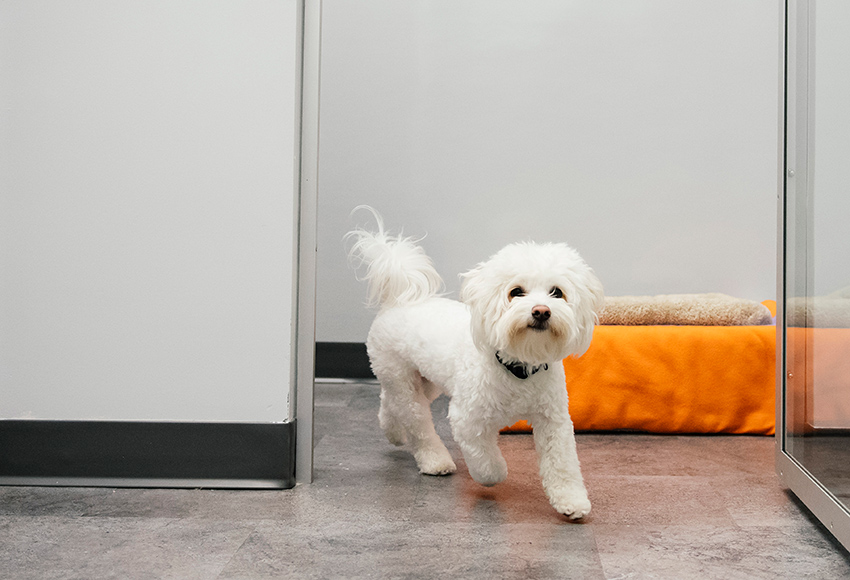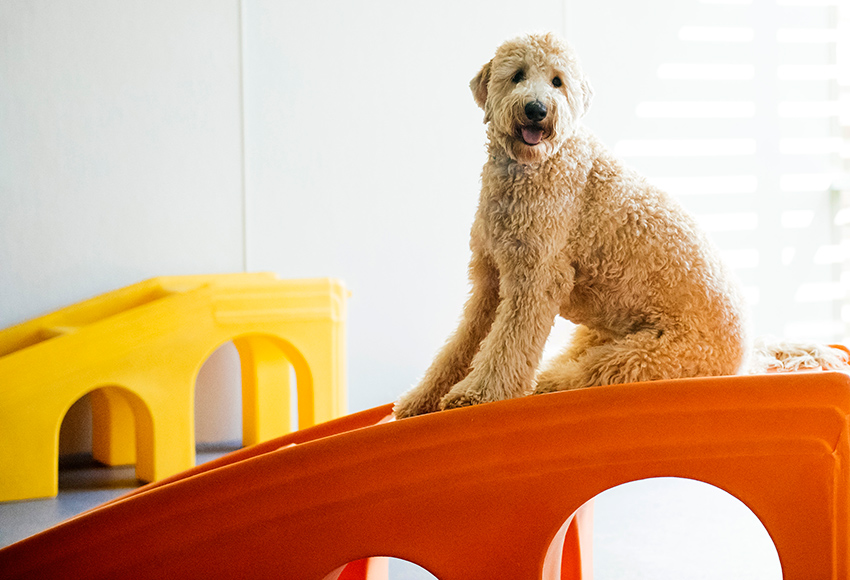Keeping Your Pup Cool is Our Job During Hot Weather

Hot weather can be dangerous for our furry friends, and spotting heat stroke in dogs isn’t always easy. That’s why it’s important to bring your dog to a dog boarding and daycare facility that truly treats them like one of their own, and is equipped with commercial grade air conditioners to keep your pup cool when the weather heats up. Dogtopia has taken every precaution to ensure that our furry clientele are comfortable while they enjoy their day of play!
Veterinarians say these are the signs every dog owner look for, including types of dogs and activity that can lead to dog heat stroke.
The full article can be read here: https://www.rd.com/advice/pets/warning-signs-heat-stroke-in-dogs/

1.Your pup is a “brachy”
In general, dogs don’t have efficient cooling systems—they can’t sweat, like humans, and they can heat up quickly. Worst among the breeds are brachycephalics, or brachys: Any dog with a flat, wide skull and a short nose—think Boston terriers, Pekingese, Shi Tzus, Pugs, and Bulldogs—will be more prone to heatstroke. That adorable face has a lot crammed into a small space, and the crowding of the soft tissues, tongue, and cartilage restricts airflow. When it’s a scorcher outside, it becomes more difficult for them because they can’t pant and breathe as efficiently to cool themselves down.
2.Your dog is hyper
Members of the working class breeds such as golden retrievers, border collies, and Labs will play and work in the heat; not having a clue they are overheating until they collapse.
3. Your pooch is pudgy or older
Heat stroke in dogs is something to pay particularly close attention to if your dog is carrying some extra pounds. According to one study of dogs treated for heat stroke, obesity nearly tripled the risk of death. The extra layers of fat in overweight dogs act as insulation and impede the ability to cool down.
4. Your dog has a coat that’s dark, long, or thick

You know that dark surfaces absorb more heat than ones, and the same is true for your pup. Huskies, Malamutes, American Eskimo dogs do not do well in the heat and should be carefully monitored when outdoors in the hot summer months.
5. Your dog is running a fever
One clear sign of heat stroke in dogs is body temperature. But the only way to know for sure is to take his temperature rectally. Dr. Rossman recommends purchasing a separate dog-only thermometer as well a thermometer covers and lubricating gel. If the rectal temperature exceeds 105° call your vet immediately. Not sure you can do the rectal method? The next best thing is an ear thermometer made specifically for animals. It’s not quite as accurate so make sure to alert your vet if you take the temp this way. It’s worth taking this extra step for your pooch.
6. Your dog is bleeding
“Bleeding can be seen from any part of the body surface if heat stroke is severe enough,” says Dr. Rossman. “Hyperthermia can cause the body to stop producing the proteins it needs to make the blood clot and it can also make it more susceptible to bacterial and toxins.” One indicator of heat stroke is uncontrolled bloody diarrhea, Dr. Rossman points out.

7. Your pooch is panting really loud
Dogs pant to regulate their body temperature. However, if the panting sounds louder or harsher and your pooch seems to be working harder to breathe and has a wide-open mouth, it’s another sign of heat stroke in dogs.
8.Your pup is drooling more than usual
VWhen your dog is panting, it inevitably drools, and you can expect a bit more panting and drool after exercise. It’s your dog’s way of dissipating the extra heat. But when the drooling is a constant stream, it’s another sign she could have heat stroke.
9. Your dog is acting weird
The symptoms of heat stroke in dogs can often resemble a drunk person. Your dog may be in a stupor, disoriented, and staggering about—or even collapse, says Dr. Rossman. These symptoms alone warrant a call to the vet, but if your dog has been exposed to high heat it could be heat stroke related.
10. Your pups chest is expanding quickly
A high heart rate and a chest expanding quickly are indicators of heat stroke in dogs. Taking your pet’s pulse is a little tricky; checking the respiratory rate is an easier alternative. “Respiratory rates can be checked by watching how many times the chest expands and contracts in the course of ten seconds. Then multiply by six,” says Dr. Rossman. The normal respiratory rate is 10-30 bpm, but since that varies with breed ask your vet what your a healthy rate is—and what rate can indicate danger.
11. Your dog has muddy or pale mucous membranes

If your dog is already drooling like a faucet and panting, this might get messy; but if you check your dogs’ mucous membranes, you may be able to identify another sign of heat stroke in dogs. Gently, pull back the upper lips and take a look at the gums. They should be pink and moist, not muddy or pale, explains Dr. Rossman says. However, some breeds, like a Saint Bernard, have naturally dark gums. In that case, get to the vet, who will likely check the inner eyelids.
Act fast
Quick action is needed to save the life of a dog suffering from heatstroke. Permanent brain and organ damage can occur when the body temperature reaches or exceeds 106 degrees. If heatstroke is severe and left untreated, coma and death can occur. Call your vet immediately and start cooling down your dog. Soak him in cool or lukewarm water and offer cool fluids but do not force-feed wate. It’s important to bring down the temperature gradually. If a tub isn’t an option, wrap your dog in towels soaked in lukewarm water. Never place your dog in an ice bath—that will cause blood vessels to constrict, slowing blood flow and interfering with cooling.

DOG DAY CARE IS BEST FOR HOT WEATHER
Dog day care at Dogtopia is the best choice for hot sunny days for a few reasons.
- Your dog gets to exercise and play in temperature controlled, cooler buildings.
- Your dog will have supervised outside time with other dogs on a limited basis, with our team constantly checking for signs of distress due to heat.
- Your dog won’t burns their sweet little paws on hot concrete or asphalt on walks, because their exercise will be indoors and outdoors in our play area.
- Your dog will stay hydrated and will have access to shaded areas when outside
Overall, dog day care is the best choice here. Never leave your dog unattended outside in hot weather, and never assume that heat stroke can’t happen to your pup. When temperatures rise, it’s better to be safe than sorry.





